macOS exFAT: Full Introduction
It is common for Mac users to select a suitable file system matching the Mac for quick access to files and data on external storage. exFAT is one type of file system that has a large number of users. However, what is the exFAT on Mac? The following content has some relevant information you should know about macOS exFAT.
macOS exFAT Definition
To be more specific, exFAT, intended for memory cards and flash drives, is an embedded operating system introduced in the latter half of 2006 as a part of Windows CE 6.0. The entire File Allocation Table (FAT) family, including exFAT, is used for embedded systems because it is lightweight, better suited for solutions with low memory and power requirements, and can be easily implemented in firmware.
macOS exFAT Features
exFAT has a file and cluster pre-allocation feature. This function creates a concept of "file pre-allocation", where you can define the file size up front and in advance before or while writing in the file. And then, a file can be pre-allocated in a vast size to attempt to get many contiguous clusters in a single allocation so that it can use that bit to say the file is contiguous and, therefore, not have to update the FAT chain.
It also uses a cluster bitmap to keep track of allocated and free clusters. The bitmap significantly reduces the number or frequency of required read-write operations of the file system. Like other FAT file systems, its simple and lean structure and power efficiency make it suitable for embedded storage solutions.
There are also specific features that make it ideal for flash memory storage. One such is boundary alignment for file system structures, which allows adjusting FAT offsets and cluster heap based on format time, thereby enabling writing on as few flash blocks as possible to preserve the integrity of the entire flash memory.
There is also an OEM Parameters field that is useful for recording the block size of underlying storage and the absence of journaling to maximize storage space and the longevity of flash memory by writing fewer data.
All these features above can be concluded in the following table.
|
Features |
Explanations |
|
File and Cluster Pre-allocation |
exFAT pre-allocates disk space for a file by just marking arbitrary space on a disk |
|
Scalability |
exFAT allows you to maximize the partition sizes as per your requirement without any limit. |
|
File Optimization |
exFAT has an increased file size reference from 4 bytes to 8 bytes for storage. |
|
Extended File Size |
Using exFAT file format, you can store large-sized files to any extent quite conveniently. |
|
Allocation Bitmap |
exFAT uses an allocation bitmap that defines whether a particular cluster is in use or free to allocate new data. |
|
Boundary Alignment |
The FAT and the clustered heap offsets are adjustable at the format point; hence, writes occur in the fewest flash blocks. |
|
OEM Parameters |
The block size of the underlying storage is a feature that can be included in the "OEM parameters" field. |
macOS exFAT Compatibility/Support
exFAT works with all modern versions of macOS; that is to say, exFAT supports the Mac OS X 10.6.5 and all later versions. For Windows users, exFAT is compatible with all versions of Windows operating systems such as Windows XP, Windows Server 2003 with update KB955704, Windows Embedded CE 6.0, Windows Server 2008, Windows 7, Windows 8, and Windows Server 2008 R2.
Except for operating systems, exFAT also supports other devices:
- Consumer devices: cameras, camcorders, digital photo frames, mobile phones, PCs, and networks.
- Storage & Media devices: USB flash drives, external hard drives, SSDs, SD cards, and newer versions of media players such as modern flat-panel TVs, media centers, and portable media players.
macOS exFAT Limitations
One significant limitation of exFAT is that it lacks the function of journaling.
A journaling functionality is a specific system where before any changes to the files on the disk are performed or before these changes transpire, they are tracked and recorded in a log or journal.
Journaling works by allocating a particular area or journal to record changes ahead of time. In other words, journaling is helpful because journals can be used to recover broken data when data corruption occurs. The absence of this capability in the exFAT makes it prone to errors caused by systems or crashes and power outages while a particular storage medium is in operation. Due to interruptions, mediums based on exFAT are susceptible to data corruption or data loss.
macOS exFAT Allocation Unit Size
The allocation unit size is the minimum disk space required to hold the file. One cluster can carry only one file, while one file can take multiple clusters based on its size and cluster size. Therefore, if the file's actual size is more than the cluster, it will acquire various clusters, while if the actual size of the file is less than the cluster, it will take at least one cluster.
According to Microsoft, which created the exFAT file system, the standard exFAT allocation unit size is:
- 7MB - 256MB: 4KB
- 256MB – 32GB: 32KB
- 32GB – 256TB: 128KB
Fix macOS exFAT Drive Not Mounting
Many posts online discuss the issue of the exFAT drive not mounting on Mac. Through further research, you will notice the exFAT drive mounting issue resulting from various causes. Here are some of the common ones:
- Unsupported exFAT allocation unit size by Mac.
- Drive corruption due to improper ejection, paused file transfer, etc.
- Faulty USB cable or port.
- Software glitches.
- Broken hard disk enclosure.
How can you solve this problem? The fixes are provided below:
- Fix 1. Manually mount exFAT drive in Disk Utility
- Fix 2. Check Finder Preferences
- Fix 3. Use First Aid to Repair the USB Corruption Error
- Fix 4. Mount exFAT Disk on Mac Using Terminal
Fix 1. Manually Mount exFAT Drive in Disk Utility
Step 1. Launch Disk Utility, and select exFAT drive.
Step 2. Click the "Mount" button in the toolbar.

Suppose it mounts your drive correctly. Congratulations. Keep reading the other solutions below if it does nothing or prompts an error.
Fix 2. Check Finder Preferences
Your disk drive may be prevented from showing up in your system settings. To fix it, you can follow these steps:
Step 1. Start Finder.
Step 2. Go to "Finder" > "Preferences".

Step 3. Click "General".
Step 4. Make sure Hard disks are checked.
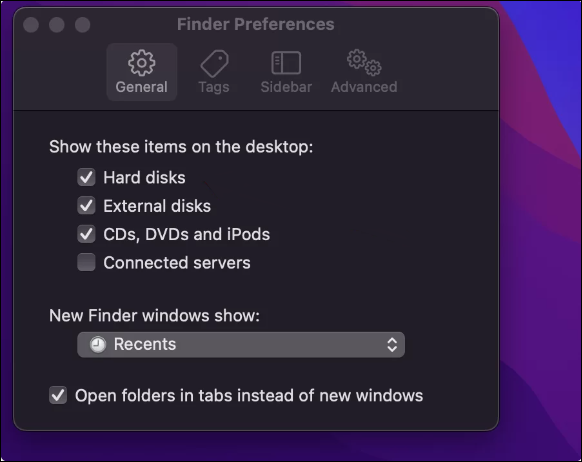
Fix 3. Use First Aid to Repair the USB Corruption Error
The first step varies depending on your processor type, but it's the same regardless if you have Mac Big Sur, Mac Monterey, Mac Catalina, or any other distribution.
Step 1. Restart your Mac.
- Using an Apple processor: Hold the power button until you see the startup options window. Click on Options and then on Continue.
- Using an Intel processor: Hold down Command + R until you see the utilities window
Step 2. Launch Disk Utility and click "Continue".
Step 3. Click on "View" > "Show All Devices".
Step 4. Select your hard drive, click "First Aid", and "Run".
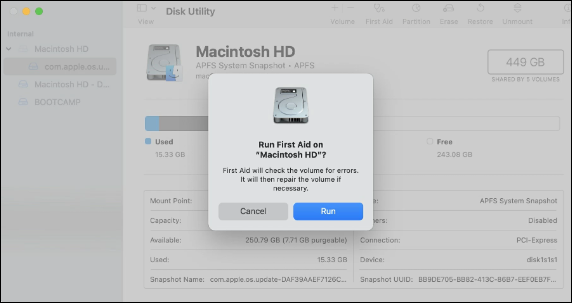
Fix 4. Mount exFAT Disk on Mac Using Terminal
Step 1. Launch Terminal from the "Applications" > "Utilities" folder.
Step 2. Copy and paste the command diskutil list in Terminal to list all drives connected to your Mac.
Step 3. Locate the identifier of your exFAT disk.
Step 4. Run the command: disk:diskutil mountDisk /dev/identifier to mount your exFAT drive.
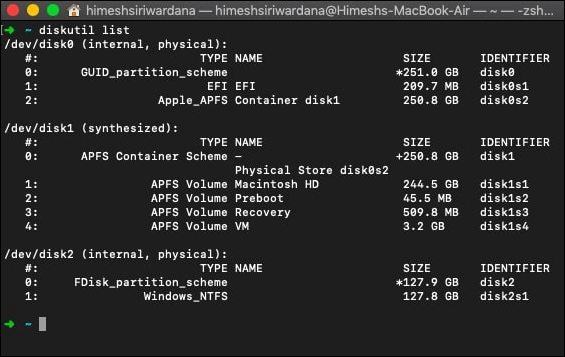
For example, if the identifier of your exFAT disk is disk2, the Command should be diskutil mountDisk /dev/disk2.
macOS exFAT Format
There are two ways to format your hard drive, the latter is meant to aim at advanced Mac users, and the former is for ordinary users.
exFAT Format with Disk Utility
In the case of a corrupted filesystem on the drive, you might need the exFAT format.
Note: All data on the hard drive will be erased! Please back up your data first.
Step 1. Lauch Disk Utility.
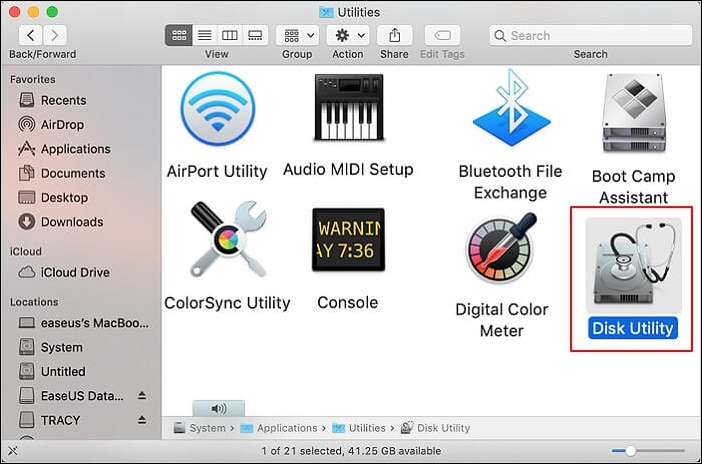
Step 2. Select the drive you want to format.
Step 3. Click "Erase".
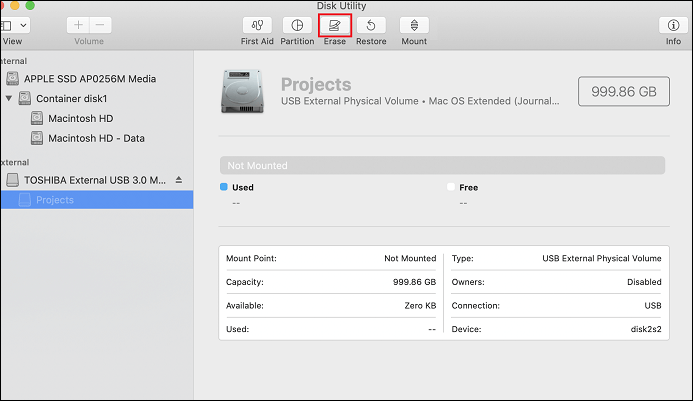
Step 4. Name the drive, select the "exFAT" format, and click "Erase" again.
Your drive will be erased and automatically formatted. Suppose you need to recover your files afterward. In that case, you can resort to EaseUS Data Recovery Wizard for Mac, powerful software to recover lost data due to formatting or corruption, with a recovery rate of 99.7%.
exFAT Format with Terminal Command
Step 1. Insert the USB into the Mac device.
Step 2. Hold the "Command + Space" and search for the "Terminal" option. Or you can go to the Finder, locate Utilities, and open the Terminal.
Step 3. Type diskutil list and find all the available devices.
Step 4. Select the drive and then run the command: diskutil erasedisk exFAT MyDisk DISK_IDENTIFIER.
exFAT vs. Mac OS Extended vs. NTFS Full Comparison
The fact is that exFAT is one type of file system, but there are still other file systems, such as Mac OS Extended and NTFS. Then one big question may arise: what is the difference between the three? The following are the comparisons.
exFAT vs. Mac OS Extended
The Mac OS Extended is also known as HFS Plus or HFS+ and is the default file system of all Macs from 1998 through now on Macs with mechanical or hybrid drives. Even if a Mac runs macOS High Sierra, the file system will be Mac OS Extended by default if it has a hybrid or mechanical drive. Just keep in mind you will need to ensure your encryption key for either, and encryption can ding your performance slightly.
And here is some advice on choosing the file systems and the comparison between exFAT vs. Mac OS Extended:
You better select exFAT and FAT32 [MS-DOS (FAT)] when formatting a USB drive or an SD card. 64GB SD card or more extensive, choose exFAT; 32GB or less, choose MS-DOS (FAT).
When formatting an external hard drive, like HDD or SSD, the recommended format is Mac OS Extended; furthermore, you can choose Mac OS Extended (Journaled). If you format a drive for use with older Macs – or are formatting a drive on an older Mac – Mac OS Extended should be your choice.
exFAT vs. NTFS
NTFS, New Technology File System, is a journaling file system developed by Microsoft. It acquires the following features:
- The journaling feature has been introduced in the former passage.
- The hard link feature allows different file names to refer directly to the same content.
- The compression feature will automatically compress any files moved or saved to the folder it is enabled on.
And the detailed exFAT vs. NTFS is tabled as below:
|
|
exFAT |
NTFS |
|
Compatibility |
All versions of Windows and Modern versions of Mac OS X and Linux. |
All versions of Windows read-only on Mac OS X by default. Read-only by default on some Linux distributions. |
|
Limits |
No realistic file or partition size limits |
|
|
File Size Limit |
Up to 16 exbibytes theoretically(limited by partition) |
Up to 256 terabytes |
|
Partition Limit |
Up to 128 pebibytes, or 144,115 terabytes |
Up to 8 petabytes |
Conclusion
This comprehensive article illustrates everything you may want to know about the macOS exFAT file system. Believe you have a relatively complete understanding of macOS exFAT. And I hope all the fixes above work for you to fix the macOS exFAT, not mounting. It has limitations of lacking journaling, but at the same time, it is a better choice when formatting a USB drive or an SD card. You can decide which one to choose between exFAT, Mac OS Extended, and NTFS based on the whole comparison part in this article.
Was This Page Helpful?
Jean is recognized as one of the most professional writers in EaseUS. She has kept improving her writing skills over the past 10 years and helped millions of her readers solve their tech problems on PC, Mac, and iOS devices.
Daisy is the Senior editor of the writing team for EaseUS. She has been working at EaseUS for over ten years, starting as a technical writer and moving on to being a team leader of the content group. As a professional author for over ten years, she writes a lot to help people overcome their tech troubles.
Related Articles
-
Windows 10 Stuck in Airplane Mode and How to Fix it
 Daisy/2025-01-24
Daisy/2025-01-24 -
Xprotectservice Explained: Apple's Built-in Antivirus Software
 Tracy King/2025-01-24
Tracy King/2025-01-24 -
Windows 11 Installation Has Failed? Your Fixes Are Here
 Tracy King/2025-01-24
Tracy King/2025-01-24 -
What Is Pagefile.sys? Is It OK to Delete It?
 Daisy/2025-01-24
Daisy/2025-01-24